Route guides: Mpafi Mpafi and Oupa Moloto
Facilitator: Ali Hlongwane
Documenter: Ismail Farouk
Early on the 24th of July 2006, a bitterly cold morning, our research group set off from the Hector Pieterson Museum and Memorial (HPMM) to retrace the main route from Morris Isaacson High School in Central Western Jabavu to Phefeni Senior Secondary School in Orlando West. Our objectives were to map the route and identify important landmarks and places of interest along the way.
Our beginning point was Jabulani Hostels in Moahloli Street at the point before the street becomes Mputhi Street. “Jabulani” means happiness. However, Mpafi Mpafi reminded us that the history of Jabulani Hostel dwellers and their relationship with township residents was not always happy. Running battles between hostel inmates and township residents occurred here during 1976.
Figure: The Research Group Standing Outside Jabulani Hostels
Factors contributing to the hostility between hostel dwellers and township residents include the use of hostel inmates as strike breakers during the stay-away of 23 -25 August 19761. The Soweto Students Representative Council (SSRC) called for mass stay-away protests between August and November 1976. Hostel dwellers ignored this stay-away call because of the intervention of the police, Inkatha and the Soweto Urban Bantu Council. This led to the harassment of hostel dwellers by township youth. Other factors included the nature of the hostel institution which created class separation from the rest of the township community1. Living conditions in hostels were squalid and inmates had no rights whatsoever. Hostels were made up of large halls with communal facilities. Common water taps, showers and toilets were provided outside hostels. The poor conditions within hostels encouraged anti-social behaviour.
From Jabulani Hostels it is possible to see the Oppenheimer Tower in the distance. We headed off towards the tower by first travelling north on Mputhi Street and then west, by turning left into Taelo Street. At the intersection of Mputhi and Taelo streets there was much paving activity, part of the JRA sidewalk paving project.
We reached Oppenheimer Tower complex which is set within parklike surroundings. The tower was built in 1955 from ash bricks which were the remains of shantytowns.
Figure: Oppenheimer Tower
The view from the tower provides a sense of the vastness of Soweto. From here looking south, there is a great view of the train-like housing architecture of Jabulani Hostels. Further in the south-west, the West Rand Administration Board (WRAB) Fresh Fruit Market is visible. The WRAB Fresh Fruit Market was set alight and destroyed on June 16 1976. We were reminded of the violence of that day’s events by Oupa Moloto recalling the gruesome sight of a headless boy lying on the ground with a cabbage under each arm.
Figure: The vastness of Soweto from Oppenheimer Tower
Other landmarks visible from the tower include the 1976 memorial acre and the former home of Tsietsie Mashinini (see below), both of which are located close by in the suburb of Central Western Jabavu which surrounds the tower complex to the north and east. Still within the Oppenheimer gardens, we took a moment under the shadow cast by the Oppenheimer Tower where Mpafi Mpafi reminded us of the running battles between township residents and hostel dwellers which occurred in the park. He also pointed out that the gardens were a place of refuge for students who hid amongst the trees.
The Oppenheimer Tower is located adjacent to The Credo Mutwa Cultural Village. The village, also known as Khayalendaba, or "Place of Stories", has always been associated with story-telling, rituals and ceremonies, plays and other cultural activities. Its founder, Credo Mutwa is a Zulu Sangoma or traditional healer, a cultural historian and an award-winning nature conservationist in South Africa. Credo who is over 80 years old, is known worldwide as the Zulu Shaman. In 1976 students thought he was a collaborator and his house in Diepkloof was burnt down in the aftermath of June 16. Later most of the cultural village was destroyed too because of Credo Mutwa’s testimony in the state’s official enquiry into the student uprisings.
Figure: Mythological Sculpture at Credo Mutwa
From the Credo Mutwa Village and Oppenheimer Tower complex we headed back to Mputhi Street and parked across from Morris Isaacson High School at the 1976 Memorial Acre, which is in the process of development. Mpafi remarked that it was students from Morris Isaacson High School who were central to the planning of the student march on June 16. One such student, Tsietsie Mashinini, lived across the road from Morris Isaacson High School.
Figure: The Home Of Tsietsie Mashinini
Today, the family of Tsietsie Mashinini is trying to purchase the former family home with a view to converting it into a family museum in honour of the fallen hero. The 1976 Memorial Acre contains a newly erected monument in Tsietsie’s honour. The monument was created as part of the Sunday Times Heritage Public Art programme. Its physical form resembles a giant book which symbolizes the crisis in education experienced in 1976. On the face of the book is the map of the route taken by the students from Morris Isaacson High School to Phefeni Junior Secondary in Orlando West, whilst the back cover of the ‘book’ is inscribed with a tribute to Tsietsie Mashinini.
Figure: Monument to Tsietsie Mashinini
We continued up Mputhi Street past the killing site of Dr Melville Edelstein. Dr. Edelstein was one of two white officials beaten to death that day. A sociologist, Dr. Edelstein worked closely with many youth from Soweto. Earlier on the fateful morning, he greeted students as they past his house on Mputhi Street. However, once news of Hector Pieterson's death filtered through the ranks, happiness turned to anger and Dr. Edelstein was murdered for being a white man in the wrong place at the wrong time. Ironically, Dr Edelstein had warned that the hostility of township youth should be taken as a serious threat to peace in Soweto. In his thesis, written five years prior to the events of June 16, "What Young Africans Think” (1971), 73 percent of the youth interviewed listed inadequate political rights among major grievances.
Figure: Dr. Melvillle Edelstein's body was found here on Mputhi Street.
We briefly left the route in order to document two houses of historical significance. The first, belonging to Titi Mthenjana was known as ‘The Headquarters’ or HQ. This house was a safe haven for students who would sleep here in order to escape harassment by the police. The second house also a safe haven for students belongs to Mr Mbatha, a student mentor and advisor. Mr Mbatha’s home has changed considerably over time but Oupa Moloto still remembers how the home hosted important meetings of the SSRC.
Figure: Mshenguville Informal Settlement
We returned to Mputhi Street and drove past Mshenguville Squatter camp, a former golf course. Further north on Mputhi Street, beyond the Roodeport intersection, the street name changes to Machaba Street. We turned right into Zulu Street and 200m ahead came to the site where Tsietsie Mashinini addressed crowds of students on the landmark bridge. The bridge is relatively unchanged since the 70s. Here Mashinini exhorted the students to remain calm and protest peacefully.
Figure: The Bridge where Tsietsie addressed students.
We continued towards Orlando West past the point where Machaba Street becomes Mahalafele Street, turned right into Phiri Street and left into Vilikazi Street. Our journey ended on Vilikazi Street at the intersection with Moema Street outside Phefeni Junior Secondary School. This is where students congregated on the morning of June 16 1976. Today this intersection has been memorialised by a monument marking the shooting site of Hector Pierterson. For many this is where the march ended as waiting police opened fire on protesting students.
Sources:
1. Moss, G. (1982): 'Crisis and Conflict: Soweto 1976-7', MA dissertation, University of the Witwatersrand.
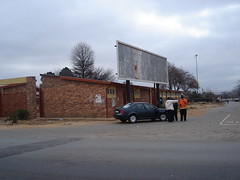
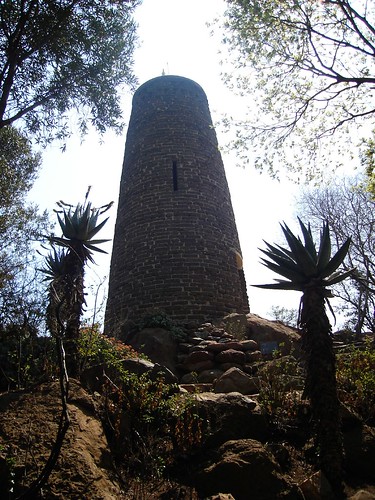
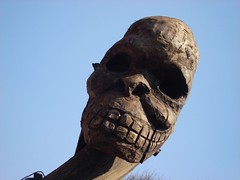
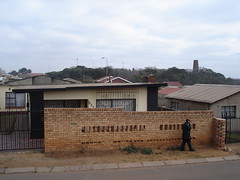
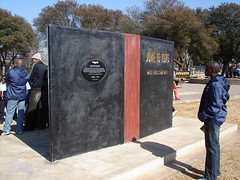
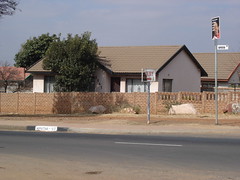
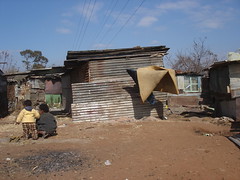

9 comments:
As a Morris Isaacson graduate and veteran of the struggle against apartheid, I feel that the modern day writers and revisionists are not honest about the seed that led to June 16, 1976.
As early as 1971, we were alraedy planting the seeds for our future struggle. Those who were at Morris will remember that BOSS (the infamous Special Branch) were already "paying visits" to my classmates and I as early as 1971 (long before) the uprising of June 16, 1976. I wrote about this harassment and threats to my life and those of my courageous classmates in an article published by the banned "Weekend World" in 1980, shortly before I went into exile.
The article was authored by one of the most courageous journalists our motherland has ever seen and my former classmate, the late "Senator" Sam Mabe, of Central Western Jabavu. When other prominent and highly educated "journalists" were hiding in the tall grass, Sam was already writing editorials demanding the release of our then incarcerated leader Tata Mandela. I have a treasure trove of Sam's editorials from those days. Sam was also witness to the BOSS activities at Morris Issacson because he was also approached by the "gentleman from the Prime Minister's office in Pretoria".
The irony of all this ignorance of the roots of Morris' later prominence is that Don Tietsi Mashinini was still in higher primary school those days. In fact, Tsietsi's parents' home was across the street from Morris Issacson's main gate, where he used to watch us and our teachers, the greatest biology teacher I ever had, the late Clarence "Locks" Mlokoti of the Kaizer Chiefs Football Club, the late Meneer Motaung, Mr. Senne, Mr. Hlaise, among others, patrolling the townships looking for the hooligans, yes, the Damara gang, which used to terrorise our schoolmates, raping the young girls, robbing and killing residents of surrounding townships of CWJ, White City and Jabulani. In fact, they used to prey on the Jabulani Hostel residents coming from work after getting off the trains at Jabulani train station.
I strongly believe that my generation strongly influenced the future political actions of Tsietsi and his heroic comrades, including my own brother and cousin, Murphy Morobe who were Tsietsi's classmates.
Another untold story about this period is that after he was expelled from my alma mater, the former University of the North (Turfloop), one of our greatest student leaders and martyrs, Onkgopotse Abram Tiro, was hired to teach at Morris because he was persona non grata in the world of apartheid. Tiro was a singularly powerful influence to our political thinking. By the way, we were blessed and honored to have him as a speaker and marshall at our "farewell function" as the graduating Class of 1972.
Being away from home since 1981 and hoping to return someday soon (I missed the gravy train back home in 1994...you know!)
The only reason I am writing this is to inform my countrymen and women that we have tons of unsung heroes in our midst and in the land of our brave Ancestors' spirits).
Lest we forget their contribution, those who are able to tell their stories before it is too late.
Sincerely yours,
Lekunutu Casalis ("Caster") Matima
New York, USA
PS I can be reached via the Morris Isaacson Alumnus Association for comments, etc.
There are more than a few types of hostels these days, and all of them tend to have their particular characteristics; some are more like normal hotels, some are a completely different experience.
Hostels in Salta
For all the supposed struggle for racial equality, the irony of them killing a white man for being white who happened to have dedicated the life they took to black equality just shows how savage and incapable of logic they are.
It's just like the LA Riots in California where they attacked people for being white, many of whom were actually sympathizers of their cause.
Typically areas with large black populations are always a ticking time bomb when they feel socially frustrated with their own lack of progress. The next riot or pogrom against whites is only one court judgement they dislike, or one overzealous cop beating away.
And once they get rid of the white populations, then black countries just turn in on themselves and go to civil war. I guess as long as South Africa has whites to blame atleast it won't turn into the Congo since Blacks will stay somewhat unified.
They need the white man as their boogeyman or they'll go back to tribal warfare.
Dr Melville Edelstein, you had a better opinion of their inner nature than they deserved, as your death had shown. May you rest in peace.
Ken, please call me on 0826006436, I'm doing some research on the uprisings and would really appreciate your view. Thanks, Rob
I am greatful to have read about you one of the history icons in South Africa and I believe you were said to be a friend of my late father Michael Mooketsi Masetlha .My name is kedibone 0793554110
Thas my school i love it morris is a realy gud place
Shift_L
I am great i have read about history especially morris isaacson high school and its still needs to be respected again
Shift_L
Thanks for sharing the best information and suggestions, I love your content, and they are very nice and very useful to us. If you are looking for the best bricks manufacturer, then visit RMS EcoBricks. I appreciate the work you have put into this.
Post a Comment